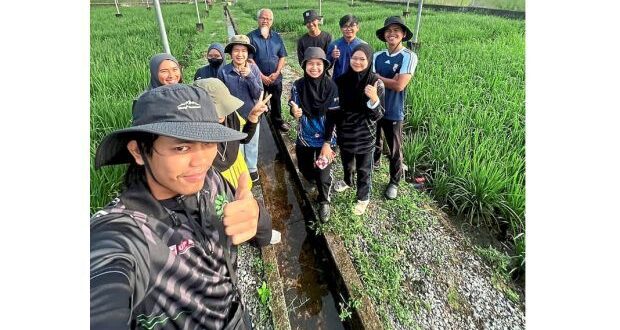AN URBAN park with an orchard and padi field is taking root in the heart of a smart township in Selangor,
The 2.8ha piece of land in Cyberjaya was set aside by Sepang Municipal Council (MPSepang) for Dusun Bandar@Cyberjaya in 2022.
Over 400 fruit tree saplings have been planted there and it is hoped that in years to come, schools, community organisations and the public can participate in workshops, guided tours and hands-on activities that promote environmental awareness and stewardship.
There are plans for the park to become a venue for visitors to learn about horticulture, ecology and sustainable living practices.
The latest addition to the park is a padi patch.
The harvested padi plant is threshed to separate the grains from the husk.
The padi planting pilot project, which began on Oct 15 last year, takes up 450sq ft.
Despite facing many challenges in its first attempt, the council’s Landscape Department which heads the venture harvested about 3kg including padi husks in February.
MPSepang president Datuk Abd Hamid Hussain said 80% of the crops had been gathered successfully.
“We knew that the soil needed to be watered well but did not anticipate the threat from foraging birds,” he added.
He explained that some of the crops had been lost to birds prior to the harvest.
“We had to quickly put up nets to protect the area from birds.
“If the nets had been put up earlier, the yield would have been much better,” said Abd Hamid, adding that they had planted the MR287 Siraj variety and learnt to cultivate it through trial and error.
Happy with the project’s success, he said the council decided to add three more plots.
Dusun Bandar@Cyberjaya will feature a larger paid field of 1,600sq ft.
“The padi field will measure about 1,600sq ft in total,” said Abd Hamid.
“I hope the yield will improve, so that we have more to share and everybody involved will get a taste of the fruits of their labour.”
He said MPSepang planted padi because it wanted a kampung feel at the urban farm.
“We want the current generation to experience the atmosphere at a rice field.
“Urbanisation has taken over many agricultural spaces and disconnected individuals from the origins of their food.
“Initiatives like this serve as vital bridges between communities and the land,” he added.
Hamid also hopes that residents will have the opportunity to engage directly with the agricultural process, gaining insights into the complexities of rice cultivation while appreciating the efforts and resources involved in food production.
Padi plants are usually inundated to prevent weeds from growing.
“It may also spur interest for some to try planting their own rice at home,” he said.
“From schoolchildren learning about crop cycles to adults reconnecting with nature, the small padi field promises to be fertile ground for cultivating knowledge, awareness and a deeper appreciation for farmers.”
Universiti Putra Malaysia (UPM) Institute of Tropical Agriculture and Food Security lecturer Prof Dr Mohd Rafii Yusop said the padi patch in the urban orchard was a good initiative to expose the public, especially those in urban areas, to where rice comes from.
“I first became exposed to the world of agriculture by helping my mother and father manage the rice fields in my hometown in Perak.
“Padi planting was my family’s rice bowl and a matter that is close to my heart.
“That is why I took up agricultural studies.
“At UPM, I am not only a researcher, but also an educator to young people who will help the government’s efforts in eradicating poverty and increasing food security,” he said.
Prof Mohd Rafii said padi planting was not an easy job.
“There are many challenges too, especially with the uncertain weather.
Abd Hamid trying his hand at harvesting padi.
“During the dry season, water supply is low and during the rainy season, the rice plants will be inundated with water,” he said.
However, he is determined to increase the country’s rice production by playing his role as a researcher for the rice plant ecosystem.
“I want to help the farmers,” said Prof Mohd Rafii.
On the initiative by MPSepang, he said it would help create awareness and ensure others, especially the younger generation, realise the labour-intensive work involved and learn to appreciate farmers.
“With the right conditions, padi can be planted anywhere in the country.
“People think padi needs to to be submerged in water and can only be planted in muddy waters.
“It is not true – padi can also be planted in a pot. It just needs extra care.
“The reason why vast padi fields are inundated in about 10cm of water is to prevent the growth of weeds.
“Otherwise, it will be back-breaking work as well to pull out the weeds,” he said.
In Selangor, padi is planted on a larger scale in the districts of Kuala Selangor and Sabak Bernam.
Solely for educational exposure, there is a padi field in Taman Botani Negara Shah Alam, which was previously known as Taman Pertanian Malaysia Bukit Cerakah.
According to the website, it was one of the first attractions that was built during the park’s construction in 1986.
Known as Laman Padi, it has six patches built across 2.1ha, with padi planted twice a year.
 BeritaKini.biz Berita Viral Terkini di Malaysia
BeritaKini.biz Berita Viral Terkini di Malaysia





